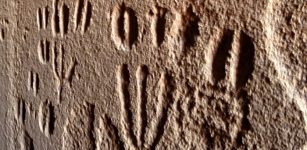Ostia Antica – Unique Ancient Harbor City In The Suburbs Of Rome
A. Sutherland - AncientPages.com - A few kilometers from Rome, there are ruins of the ancient city of Ostia ( Ostia (literally translated as "the mouth"), which by its historical importance and preservation is not inferior to Pompeii and Herculaneum, the two famous flourishing Roman towns engulfed by Vesuvius eruption on August 24, AD 79.
Today, Ostia (modern Ostia Antica) is the most significant archaeological site in the vicinity of Rome. It is believed that Ostia Antica may have been one of the very first Roman colonies.
According to an ancient legend, Ancus Marcius (642 to 617 BC), the semi-legendary fourth king of Rome, founded the port of Ostia at the mouth of the Tiber River.
There is an inscription that confirms the establishment of the old castrum of Ostia in the 7th century BC. The oldest archaeological remains so far discovered date back to only the 4th century BC and the most ancient buildings preserved until today, date back to the 3rd century BC.
Augustus who was a Roman statesman, military leader and the first Emperor of the Roman Empire, controlling Imperial Rome from 27 BC until his death in AD 14, contributed much to Ostia's importance.

Ruins of Ostia Antica. Source
The city was provided with a theater, a first forum, and an aqueduct. Important for the city was also the construction of the port of Claudius, and particularly that of the port of Trajan.
Both these constructions further increased Ostia's importance as an administrative center for trade. When Rome developed a navy, Ostia became a naval base, complete with a fort and served as the main fleet base on the west coast of Italy. By AD 150, when Rome controlled the entire Mediterranean region, Ostia was also a busy commercial port.
Originally the Tiber River flowed into the sea precisely at the spot where the Romans founded the ancient port city of Ostia in the 4th Century B.C. The name itself is derived from the Latin word “ostium” for – estuary.
By the 2nd century AD, it had become a flourishing commercial center inhabited by more than 100,000 people. Today, Ostia’s people are gone, but the ruined houses, mosaics on the floors, frescoes on the walls, paved roads, piazzas, empty taverns, and grocery shops are still intact.
Surprisingly well-preserved are also avenues and streets that give an idea of what life was like in an ancient commercial seaport during the height of the Roman Empire.
Among other structures, there are city’s public baths, a necropolis, many apartments where the poor dock workers lived, Christian chapels, docks, and warehouses.
See also:
Herculaneum Time Capsule: Ancient Scrolls With Secrets Buried Under Volcanic Ash And Stones
“Altar Of Twelve Gods” At Gabii, Italy Was Once An Important Ancient Place
Bizarre Ancient Lie Detector – The Mouth Of Truth – Bocca della Verità
There is also the well-preserved amphitheater, built in the AD 1st and 2nd centuries, with 2,700 seats. Several giant marble theater masks still survive on tufa columns at the stage.
Ostia Antica is preserved because of the sand and mud from the Tiber that covered the port after it had been abandoned when Rome fell in the 5th century AD.
With the end of the Roman Empire, Ostia fell slowly into decay and was finally abandoned in the 9th century due to several invasions and sackings. The remaining inhabitants moved to Gregoriopolis.
Later, the city was plundered for their marble to build the cathedrals in Orvieto, Florence and Pisa, Florence, and Orvieto.
During partial excavations, archaeologists unearthed remains of several temples dedicated to the Roman gods, a synagogue, a Christian basilica and many temples dedicated to the Persian god Mithras.
Ostia’s small museum features many interesting statues representing different religions of foreign countries. We must not forget that the Roman Empire’s busy seaport accommodated people practicing different religions from all over the world.
Written by – A. Sutherland - AncientPages.com Senior Staff Writer
Copyright © AncientPages.com All rights reserved. This material may not be published, broadcast, rewritten or redistributed in whole or part without the express written permission of AncientPages.com
Expand for referencesReferences:
More From Ancient Pages
-
 Creepy Story Of Lucida Mansi Who Was Obsessed With Her Beauty
Featured Stories | Jul 31, 2019
Creepy Story Of Lucida Mansi Who Was Obsessed With Her Beauty
Featured Stories | Jul 31, 2019 -
 Remarkably Well-Preserved 2,500-Year-Old Canoe Discovered In Swiss Lake
Archaeology | Sep 16, 2023
Remarkably Well-Preserved 2,500-Year-Old Canoe Discovered In Swiss Lake
Archaeology | Sep 16, 2023 -
 On This Day In History: Edgar Allan Poe Known For Tales Of Mystery And Macabre Was Born – On Jan 19, 1809
News | Jan 19, 2017
On This Day In History: Edgar Allan Poe Known For Tales Of Mystery And Macabre Was Born – On Jan 19, 1809
News | Jan 19, 2017 -
 Mysterious Ancestor Of All Mammals Identified Through Genome Reconstruction
Archaeology | Sep 30, 2022
Mysterious Ancestor Of All Mammals Identified Through Genome Reconstruction
Archaeology | Sep 30, 2022 -
 Keeladi Excavations Reveal Unique 2,000-Year-Old Terracotta Pipelines, Open Water Channel
Archaeology | Oct 30, 2019
Keeladi Excavations Reveal Unique 2,000-Year-Old Terracotta Pipelines, Open Water Channel
Archaeology | Oct 30, 2019 -
 Mystery Of The Lost Continent Destroyed By An Ancient Cataclysm – Wars Between The ‘Yellow Men And Black’ Men – Part 1
Ancient Mysteries | Aug 10, 2021
Mystery Of The Lost Continent Destroyed By An Ancient Cataclysm – Wars Between The ‘Yellow Men And Black’ Men – Part 1
Ancient Mysteries | Aug 10, 2021 -
 Mystery Of The Neanderthals – Search For Traces Of Neanderthals’ Lives And Hints Of Their Demise
Archaeology | Sep 26, 2022
Mystery Of The Neanderthals – Search For Traces Of Neanderthals’ Lives And Hints Of Their Demise
Archaeology | Sep 26, 2022 -
 Largest Ever Human Family Tree: 27 Million Ancestors Mapped
Archaeology | Feb 25, 2022
Largest Ever Human Family Tree: 27 Million Ancestors Mapped
Archaeology | Feb 25, 2022 -
 Has The Mystery Of The Hobbits Finally Been Solved?
Archaeology | Apr 21, 2017
Has The Mystery Of The Hobbits Finally Been Solved?
Archaeology | Apr 21, 2017 -
 Englishmen Jailed For Stealing Rare Viking Hoard Worth Millions
Archaeology | Dec 1, 2019
Englishmen Jailed For Stealing Rare Viking Hoard Worth Millions
Archaeology | Dec 1, 2019 -
 Anne Askew: Woman Of Great Courage, Strong Beliefs And Principles Who Was Arrested For Heresy, Imprisoned, Tortured And Burnt At The Stake
Featured Stories | Feb 15, 2019
Anne Askew: Woman Of Great Courage, Strong Beliefs And Principles Who Was Arrested For Heresy, Imprisoned, Tortured And Burnt At The Stake
Featured Stories | Feb 15, 2019 -
 Is The Poverty Point Octagon World’s Largest Ancient Solstice Marker?
Featured Stories | May 21, 2017
Is The Poverty Point Octagon World’s Largest Ancient Solstice Marker?
Featured Stories | May 21, 2017 -
 Extremely Rare Medieval Folding Chair Reveals Its Secrets
Archaeology | Oct 13, 2023
Extremely Rare Medieval Folding Chair Reveals Its Secrets
Archaeology | Oct 13, 2023 -
 Oral Stories Of Australia’s First Nations Might Be 10,000 Years Old – Evidence Found
Archaeology | Aug 2, 2023
Oral Stories Of Australia’s First Nations Might Be 10,000 Years Old – Evidence Found
Archaeology | Aug 2, 2023 -
 Amazing Time Capsule – La Roche-Cotard Cave Sealed For 50,000-Years Offers Evidence Neanderthals Were The World’s First Artists
Archaeology | Nov 22, 2023
Amazing Time Capsule – La Roche-Cotard Cave Sealed For 50,000-Years Offers Evidence Neanderthals Were The World’s First Artists
Archaeology | Nov 22, 2023 -
 Animal Tracks And Human Footprints In Prehistoric Hunter-Gatherer Rock Art In Namibia
Archaeology | Sep 13, 2023
Animal Tracks And Human Footprints In Prehistoric Hunter-Gatherer Rock Art In Namibia
Archaeology | Sep 13, 2023 -
 47,000 Years Of Aboriginal Heritage Was Destroyed In Mining Blast – Results From Juukan Gorge Show
Featured Stories | Jul 22, 2024
47,000 Years Of Aboriginal Heritage Was Destroyed In Mining Blast – Results From Juukan Gorge Show
Featured Stories | Jul 22, 2024 -
 Djoser – Most Outstanding King Of The Third Dynasty In Ancient Egypt And His Step Pyramid
Featured Stories | Sep 7, 2021
Djoser – Most Outstanding King Of The Third Dynasty In Ancient Egypt And His Step Pyramid
Featured Stories | Sep 7, 2021 -
 Alexander Nevsky: Grand Prince Of Novgorod, Skilled Fighter, Quick–Thinking Strategist Who Defeated Swedish And German Invaders
Featured Stories | Feb 22, 2019
Alexander Nevsky: Grand Prince Of Novgorod, Skilled Fighter, Quick–Thinking Strategist Who Defeated Swedish And German Invaders
Featured Stories | Feb 22, 2019 -
 On This Day In History: Battle Of Marathon Was Fought – On Sep 12, 490 BC
News | Sep 12, 2016
On This Day In History: Battle Of Marathon Was Fought – On Sep 12, 490 BC
News | Sep 12, 2016



